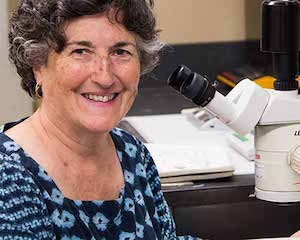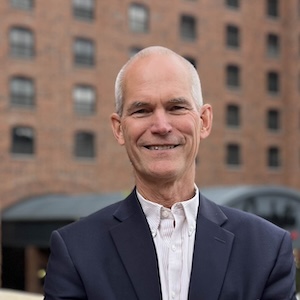Grace Anderson
“Initially I thought this program was for people who already had a degree and wanted another credential,” says Grace Anderson. “But this isn’t just certification. This is a serious degree.”
Anderson, with undergraduate degrees in biology and psychology, worked in the health care industry “in a previous life.”
She found the Master of Professional Studies in Horticulture, which was then the Master of Agriculture in Horticulture, through her passion for gardening and a timely introduction to the University. While working on a UMN Extension Master Gardener project, she met a scientist from the U of M who asked Anderson to assist her in the University’s Plant Disease Clinic.
“And that’s how I fell into plant pathology,” she says.
The Right Degree
While working in the Plant Disease Clinic, Anderson learned that the American Hosta Society was looking to fund research into Hosta Virus X. Anderson, who had just begun her master’s program and was looking for a project, met with the Hosta Society and Dr. Ben Lockhart and agreed to work on the project. The Society funded the research for two years, which they published and which became her master’s project.
“I was in my 50s,” she recalls. “I didn’t have time to go back and take (the courses) I took in the 1970s and 80s when I got my first degrees, or take the GREs. This program accepted my two degrees and the work I was currently doing, and I was able to complete it quickly and economically.”
By then, with both of her sons in college, Anderson was able to return to school. “There was one year when I had to fill out three FAFSA forms, one for each of my sons and one for me.”
"When I realized I had the chance to switch from human health care to something else, I thought about plants.”
She juggled her home, children, and part-time jobs, but with student loans and a small stipend, she was able to devote more time to her education and her lifelong love of plants.
“I always loved working in the garden with my dad. We had 10 acres, and we grew every kind of plant and I drove every kind of machine... It’s been about plants forever. When I realized I had the chance to switch from human health care to something else, I thought about plants.”
The Right Place
“I give credit to the program for being adaptable,” she continues. “They allowed me to do it in a way that met my needs and their requirements. I wanted to do it quickly, and I really, really wanted to do research that could be applied to an immediate need.”
When Anderson was studying viruses in Hosta, another researcher suggested she apply for a job that she was soon vacating. So before Anderson even graduated, she landed a job in the University’s Soybean Pathology Lab with Dr. Jim Kurle.
The lab, where Anderson is still the lead scientist and lab manager, studies the ecology and management of soybean diseases important in Minnesota.
“I had the diagnostic experience from my health care days combined with knowledge about plant diseases… and it all came together for me on this campus.”
Favorite Course
“There was a course in restoration ecology that just blew my mind. And I liked any course about identifying plants. I’m impatient and have a short attention span, but I was passionate about this. I made flashcards and memorized hundreds of plant identifiers.”
Advice for Future Students
“It took me a long time to be brave enough to do this; don’t waste time but don’t jump in until you’re ready. Come up with a plan that’s viable. Figure out what you want, and be confident that you deserve to be there.”










